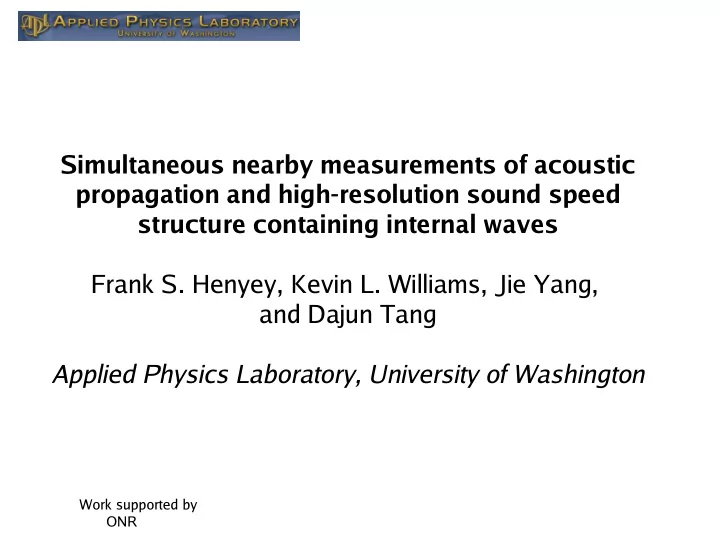

Simultaneous nearby measurements of acoustic propagation and high-resolution sound speed structure containing internal waves Frank S. Henyey, Kevin L. Williams, Jie Yang, and Dajun Tang Applied Physics Laboratory, University of Washington Work supported by ONR
Experiment Part of Shallow Water 2006 (SW06) Measure environment and acoustic propagation together (2 ships + mooring) Effect of Nonlinear internal waves (NLIW’s) Quantitative, deterministic computation of acoustic effects from NLIW’s Mid-frequency broadband acoustics: 1.5 to 10 kHz [0.13 ms resolution]
Data Collected Aug. 13, 2006 Environmental measurements: Towed CTD chain ~ 50 CTD units, ~1 m vertical spacing 7 loops around acoustic path (1.5 loops with NLIW’s) 2 s sampling @ 6 kts ship’s GPS for positioning (R/V Endeavor) Ship’s CTD profile ~ 1 hr before the NLIW’s arrived (R/V Knorr) Acoustic measurements: Broadband pulse every 13 s from R/V Knorr to MORAY receiver mooring 1 km acoustic path at 300° compass heading 80 m depth
Endeavor track & acoustic path 3 NLIW 2 1 Distances from 73°W, 39°N
Sound Density speed Sound Sound speed speed
CTD profile @ 15:30 C = 1510 m/s Defines thermocline position Warm, salty water
Acoustic Data NLIW’s t(arrival 2) = 0
NLIW model 3. Find thermocline depth (c = 1510 m/s) for towed CTD every 2 s; low pass 5. Find front of both waves, back of first wave (2 m above deepest part) 7. Linearly interpolate in space & time from all 3 legs 9. Fill in linearly interpolated amplitude, back of wave 2 & bore (15 meters → 17 m) 11.Connect with a smooth curve 13.Fill in the other sound speeds using 15:30 SSP Vertically Lagrangian mode 1
Measured internal wave parameters Front of Back of Front of first wave first wave second wave Speed 0.587 m/s 0.606 m/s 0.564 m/s Bearing 324.3¡ 316.8¡ 331.4¡ Time at 73W, 39N 15:14:26 15:19:57 15:23:01 Speed along acoustic path 0.643 m/s 0.632 m/s 0.658 m/s Average 0.644 m/s
NLIW model 3. Find thermocline depth (c = 1510 m/s) for towed CTD every 2 s; low pass 5. Find front of both waves, back of first wave (2 m above deepest part) 7. Linearly interpolate in space & time from all 3 legs 9. Fill in linearly interpolated amplitude, back of wave 2 & bore (15 meters → 17 m) 11.Connect with a smooth curve 13.Fill in the other sound speeds using 15:30 SSP Vertically Lagrangian mode 1
NLIW model 3. Find thermocline depth (c = 1510 m/s) for towed CTD every 2 s; low pass 5. Find front of both waves, back of first wave (2 m above deepest part) 7. Linearly interpolate in space & time from all 3 legs 9. Fill in linearly interpolated amplitude, back of wave 2 & bore (15 meters → 17 m) 11.Connect with a smooth curve 13.Fill in the other sound speeds using 15:30 SSP Vertically Lagrangian mode 1
Comparison of two reference frames Linear NLIW Following K. Lamb
Range-independent PE calculation (15:30)
Ray Trace with NLIW’s TB, BT, TBT,SBS arrivals
Modeling results The ray trace captures the main features in the arrival time ~ 1 ms shortening of travel time when the ray turns in the thermocline and a wave coincides with that turning point Passing through the thermocline has much less effect Can we understand the systematic 1 ms shortening? 1. Ray path different (2nd order perturbation) 2. Faster sound speed (1st order)
Selected rays TBT rays TB ray
Interpretation ? SBS ray: ~ 0 from path distortion, ~0.3 ms from ss change, events overlap
Conclusions Towed chain measurements can be interpolated onto the acoustic path, but some assumptions are needed. Acoustic modeling (PE & ray trace) obtains correct travel time. Rays turning in the thermocline with a wave present are 1 ms faster Attempted interpretation is partially successful
Recommend
More recommend